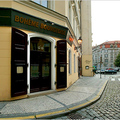Three decades after his Pompidou Center in Paris turned the architecture world upside down and brought him global fame, the British architect Richard Rogers has been named the 2007 winner of the Pritzker Prize, the profession’s highest honor.
In the citation accompanying its decision, to be announced today, the Pritzker jury saluted Mr. Rogers for his “unique interpretation of the Modern Movement’s fascination with the building as machine, an interest in architectural clarity and transparency, the integration of public and private spaces, and a commitment to flexible floor plans that respond to the ever-changing demands of users.”
In a telephone interview from London, Mr. Rogers, 73, said he did not see the award as overdue. “It’s not when it comes, it’s the gift that matters,” he said. (Renzo Piano, his co-architect on the Pompidou Center, received the Pritzker in 1998.)
The award — a $100,000 grant and a bronze medallion — is to be presented at the Banqueting House in London on June 4.
Mr. Rogers earned a reputation as a high-tech iconoclast with the completion of the 1977 Pompidou Center, with its exposed skeleton of brightly colored tubes for mechanical systems. The Pompidou “revolutionized museums,” the Pritzker jury said, “transforming what had once been elite monuments into popular places of social and cultural exchange, woven into the heart of the city.” Similarly, his 1986 Lloyd’s office building in the heart of the London financial district features a inside-out design, with a soaring atrium surrounded by external escalators and elevators.
Asked to describe his own stylistic signature, Mr. Rogers said he was recognized for “celebrating the components and the structure.”
“That’s how we get rhythm and poetry out of it,” he said. He added that he would like to be known for “buildings which are full of light, which are light in weight, which are flexible, which have low energy, which are what we call legible — you can read how the building is put together.”
Other high-profile projects by Mr. Rogers include the sprawling Millennium Dome in Greenwich, England, suspended from steel masts and secured by steel cable (1999), and the law courts in Bordeaux, France (1998) — seven “pods” clad in cedar wood surrounded by glass walls under an undulating copper roof.
Mr. Rogers’ most recent major undertaking was the $2.2 billion new terminal at Barajas International Airport in Madrid (2005), featuring waves formed by wings of prefabricated steel and a roof covered in bamboo strips. Earlier he designed Terminal 5 at Heathrow Airport in London.
While he had been largely absent from New York, Mr. Rogers now has four projects under way in the city: an expanded the Jacob K. Javits Convention Center on the Far West Side of Manhattan; a tower at the World Trade Center site; a complex at Silvercup Studios in Long Island City, Queens; and a redesign of the East River waterfront.
Not all of these designs have been well received. Appraising Mr. Rogers’s vision for the Javits Center in The New York Times, Nicolai Ouroussoff said its boxy design was “a decent but not particularly dazzling work of architecture.”
But he offered glowing praise for Mr. Rogers’s reimagination of the East Side waterfront, designed in collaboration with Gregg Pasquarelli of SHoP Architects and the landscape architect Ken Smith.
“The idea is to create a seamless, contemplative environment along the waterfront that embraces both the fine-grained scale of the surrounding communities and the monumental scale of the freeway,” Mr. Ouroussoff wrote. “In doing so, the architects shrug off the conflict between Modernists and historicists that absurdly still defines so many urban planning debates in New York.”
Mr. Rogers said he was gratified by his New York commissions. He described the Javits project as “the most complex, but also the most exciting potentially — as a public space that could create the regeneration of a large area which is very depressed.”
Over the years he has become well known for his philosophy as well as for his buildings. His London firm, Richard Rogers Partnership, has adopted bylaws specifying that the directors get no more than six times the salary of the lowest-paid architect. “I don’t believe in the ownership of work,” he said.
The firm, which was founded in 1977 and has offices in Barcelona, Madrid and Tokyo, will be renamed Rogers Stirk Harbour & Partners next month. “It’s time to start to broaden the top,” Mr. Rogers said.
He has also been in the forefront of the sustainable architecture movement, designing buildings with the environment in mind. His building for the National Assembly for Wales in Cardiff halved the parliament’s energy consumption, he said; as chief adviser on architecture and urbanism to the mayor of London he has encouraged the construction of more compact developments around mass transportation.
“It’s always been part of our work,” he said. “I don’t think we realized the limited number of years before were going to have such serious problems, that mankind might be wiped off the earth. Certainly it’s become much more urgent.”
Mr. Rogers, the 31st Pritzker laureate, was born in Florence, Italy, in 1933. His father was a doctor, and his mother had a great interest in modern design, he said. In 1938 the Rogers family moved to England, where he struggled through the public school system; many years later he received a diagnosis of dyslexia. “I was called backward,” Mr. Rogers said. “We didn’t know dyslexia.”
Just as he was completing secondary school in 1951 — and seriously considering a career in dentistry — the Festival of Britain introduced him to modern architecture. He was captivated by some of the temporary buildings thrown up along the South Bank.
A two-year stint in the British military took him to Trieste, where he became acquainted with the work of his father’s cousin Ernesto Rogers, one of Italy’s prominent architects, and he decided to attend the Architectural Association School in London.
In 1961 Mr. Rogers traveled to Yale on a Fulbright scholarship to pursue a master’s degree in architecture. There he developed an interest in Frank Lloyd Wright (“my first god,” he has said).
After working for Skidmore, Owings & Merrill in New York, he returned to England to start his first practice, Team 4, with his first wife, Su Brumwell; Norman Foster; and Wendy Cheeseman.
Mr. Rogers and Mr. Foster each struck out on their own in 1967. By 1971 Mr. Rogers had joined forces with Mr. Piano to create Piano & Rogers. That year they won the commission to design the Pompidou, where Mr. Rogers’s work will be featured in an exhibition this fall.
Mr. Piano and Mr. Rogers split in 1978.
Over the years Mr. Rogers has racked up plenty of accolades, including a life peerage in 1996.
But the honors have not convinced him that architects deserve the rock-star status that so many enjoy. Richard Rogers Partnership employs more than 100 people, he pointed out, and he could not achieve what he does without them.
“You are leading a team,” Mr. Rogers said. “I’ve never really understood how architects can think of themselves as an individual.”





